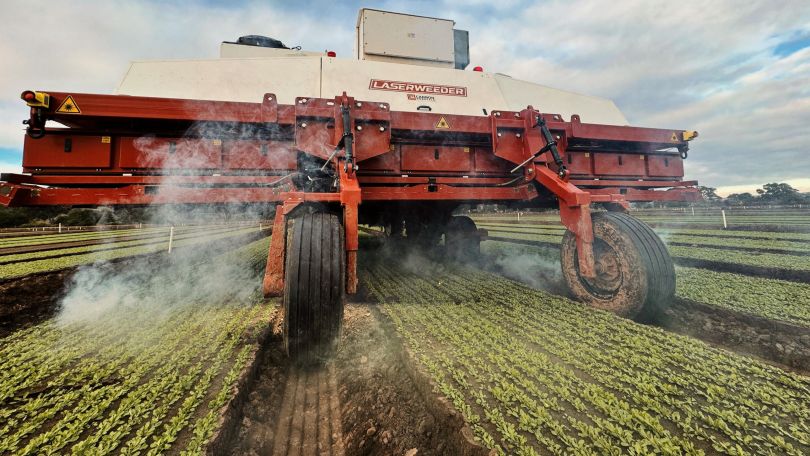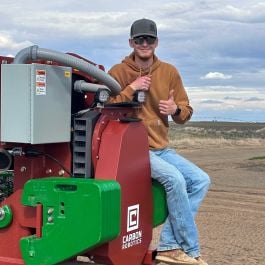When you think about the future, you might picture flying cars zooming overhead during the morning commute.
Or maybe you imagine boarding a rocket to space on your way to a luxury vacation.
Or you might imagine a farmer remotely operating a robot while it moves across the field and zaps away thousands of weeds a minute with precision lasers.
That last example isn’t in the future — it’s a customer today using the LaserWeeder from Carbon Robotics.
The LaserWeeder is the flagship piece of tech from Carbon Robotics. It combines computer vision, AI/deep learning, robotics, and lasers to identify and eliminate weeds with sub-millimeter precision. The LaserWeeder farm implement connects behind a tractor and operates on over 100 different crops today. Farmers in North America, Europe and Australia are using LaserWeeders to reduce costs, increase yields, and have a healthier more sustainable solution than traditional herbicides and mechanical cultivation.
Mason Fontes is an implementation manager at Carbon Robotics. It’s not the lasers or even the AI that stands out when Fontes thinks about work; it’s how the team goes above and beyond to make sure this emerging tech works exactly how it should for farmers.
“The amount of support that the customer receives is what stands out the most about Carbon Robotics and our products,” said Fontes.
“The amount of support that the customer receives is what stands out the most about Carbon Robotics and our products.”
“I have seen 10-15 people, from all different departments in the company, out at a customer’s machine trying to put their heads together and find a resolution to the problem the customer is facing,” Fontes continued. “That kind of support is very hard to find these days, and we have no intention of changing how we support our customers. They will continue to receive the best service and support in the ag industry.”
Built In spoke with Fontes about what it takes to build and update the LaserWeeder.
Why is your team so enthusiastic about the LaserWeeder? What are some of its technical capabilities that you are most excited to share?
Mason Fontes, Implementation Manager
Our team at Carbon Robotics is always excited to talk about our one-of-a-kind LaserWeeder. Internally known as “SLAYER,” the LaserWeeder is a 20-foot implement housing a total of 30 150-watt CO2 lasers.
Using advanced AI and deep learning technology, we are able to detect the smallest of weeds and eliminate them with sub-millimeter precision. We are also able to leverage our computer vision and detection systems to give farmers visibility into their fields, such as dense weed patch areas and crop stand counts.
Where did the need for the LaserWeeder come from?
We saw a huge need from growers for a new tool to help with weed control that didn’t require hand labor, was chemical-free and did not disrupt the soil or crops. They also wanted to reduce weed-control costs, increase yields and boost farm profitability.
Additionally, this would allow growers to almost completely get rid of their chemical usage, which leads to better stands, healthier and fuller crops and ultimately a cleaner, more profitable harvest.
“The LaserWeeder allows growers to almost completely get rid of their chemical usage, which leads to better stands, healthier and fuller crops and ultimately a cleaner, more profitable harvest.”
What was most important for your team during the development of the LaserWeeder?
Collecting and communicating direct input from growers in the field was critical in the design and iteration of the LaserWeeder product. It was extremely important that we build a product that is user-friendly so almost anyone on the farm could operate the technology and go kill weeds.
The way I always looked at it was that we are building a piece of farm equipment that incorporates very advanced computers and technology, but it must be able to withstand the farming day-to-day realities like rough roads, harsh weather conditions, aggressive lowering and raising of the implement, and long-haul transportation.

What, or who, do you think is your greatest asset on the team?
Aside from the growers, our most important asset at our company is the variety of minds and skill sets that we have here at Carbon Robotics. From engineers to our support team to our field team, there are so many great minds that continually have new ideas on how to improve our product for customers.
What obstacles did you encounter along the way?
Releasing a new product is tough and often you don’t know what you don’t know. There were some changes we had to make after releasing the first LaserWeeder that we didn’t necessarily expect — some of these being hardware, software and deep learning related.
We reacted quickly to problems as they arose in the field, and our teams put their heads together to make these fixes and changes. To test and validate solutions, we actively utilize an internal LaserWeeder that is run by our product team. We use this internal LaserWeeder to test hardware changes, new software and new crops. We can also run demos with it. This is very valuable because it allows us to test and validate anything on this unit before we release it to customers running our worldwide fleet of LaserWeeders.
What teams did you collaborate with in order to get this across the finish line?
All teams at Carbon Robotics were involved in getting the first LaserWeeder out the door and into the field. Each team had a knowledge base that was extremely valuable in the “bring-up” and release of LaserWeeder.
After the first LaserWeeder was delivered, getting key people from different functions out to the field — to observe firsthand and to discuss problems and solutions — was key to innovating rapidly and building a better and better product for our customers.







